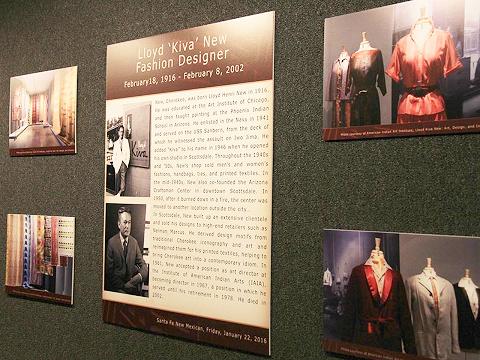 |
Canku Ota
|
 |
|
(Many Paths)
|
||
|
An Online Newsletter
Celebrating Native America
|
||
|
August 2016 - Volume
14 Number 8
|
||
|
|
||
|
CHC Exhibit Gives
Visitors Look Into Cherokee Textiles
|
||
|
by Stacie Guthrie -
Reporter Cherokee Phoenix
|
||
|
PARK HILL, OK – The Cherokee Heritage Center is giving visitors a look into the clothing and textiles of the Cherokee people with its “Threads of Time” exhibit. The show features garments, jewelry, historic photographs and an antique loom used by the Sequoyah Indian Weavers Association.
CHC Executive Director Candessa Tehee said the exhibit, which runs until Aug. 20, is important because it “shows innovation through time.”
“The clothing of Cherokee people is really important for a lot of reasons,” she said. “It shows innovation through time first of all. For instance, as Cherokee National Treasure Tonia Weavel points out, if you look at the wrap skirt, it’s changed mediums through time but the basic structure of the design has remained the same.” Tehee said most of the clothing featured would have been “everyday” clothing. She said there are also “special garments” and garments specific to genders on display. “Some of the turkey feather capes, depending on how they were made, they were made specifically for leaders or individuals in the tribe,” she said. “The twine bags, it’s said, were specifically worn by men. They were kind of the first tool bags so women weren’t really carrying their items in those woven bags. They were actually using baskets and things like that to carry and transport any items or any kind of tools that they had and they used. So there were definitely different articles of clothing that were specific to certain people or even to certain genders.”
Tehee said it’s important to note that in most cases females mainly created textiles and clothing. “In addition, I would say that looking at Cherokee clothing is important as well because it’s often the product of female artists,” she said. “There’s not enough attention paid to the work of female artists, so I think that the exhibit is important for that reason.” She said Cherokee National Treasure Dorothy Ice and Weavel are
two women whose work is on display. Tehee said the exhibit also presents male artists Lloyd Kiva New and Wendell Cochran. “Also, we’re shedding light on Lloyd Kiva New, who was a haute couture designer. He was a high fashion designer, international known, and was also the (co-) founder of the Institute of American Indian Art,” she said. “As well as the work of Wendell Cochran, who was one of the primary designers for the modern day tear dress that is the official regalia for Miss Cherokee.” Tehee said the exhibit also shows how the Cherokee way of adapting to the clothing styles of the eras. “Cherokee people were innovators but they were also highly adaptable. So they would take anything that was in their environment and once they took it on and adopted it they considered it to be Cherokee.”
She said an article on display that shows this adaptability is the “Milam Jacket,” which was created for Principal Chief J.B. Milam. In 1941 President Franklin D. Roosevelt appointed Milam as principal chief. Overall, Milam was appointed principal chief three times and served until 1949 when he died while in office, according to “A Cherokee Encyclopedia” by Robert J. Conley. “The coat was actually created for him, and you can tell that it’s a Cherokee-style hunting jacket, but the material itself was loomed by the Sequoyah weavers, and it was constructed by one of the Sequoyah weavers specifically for him in his role as chief,” she said. “That coat itself really represents the hunting jacket. It was an adoption. It was something that we adopted from settlers essentially. This is a true example of how Cherokees take things and we make it ours because from the fabric to the color choices it’s all very, very Cherokee.” Tehee said on display are also photographs and excerpts describing clothing. “You will see photographs of girls from the Cherokee National Female Seminary. You’ll also see photographs of just kind of your average everyday citizen… This (exhibit) goes back actually to pre-contact to modern times so we’ve included as many photographs of Cherokees wearing a variety of clothing as we can,” she said. “Also featured are some historical documents that describe the types of clothing that people saw from before the photographic record.” For more information, visit www.cherokeeheritage.org or call 918-456-6007.
|
||||||||
|
|
|
|
||
|
|
||
| Canku Ota is a free Newsletter celebrating Native America, its traditions and accomplishments . We do not provide subscriber or visitor names to anyone. Some articles presented in Canku Ota may contain copyright material. We have received appropriate permissions for republishing any articles. Material appearing here is distributed without profit or monetary gain to those who have expressed an interest. This is in accordance with Title 17 U.S.C. Section 107. | ||
|
Canku Ota is a copyright ©
2000 - 2016 of Vicki Williams Barry and Paul Barry.
|
||
 |
 |
|
|
The "Canku
Ota - A Newsletter Celebrating Native America" web site and
its design is the
|
||
|
Copyright ©
1999 - 2016 of Paul C. Barry.
|
||
|
All Rights Reserved.
|
||



